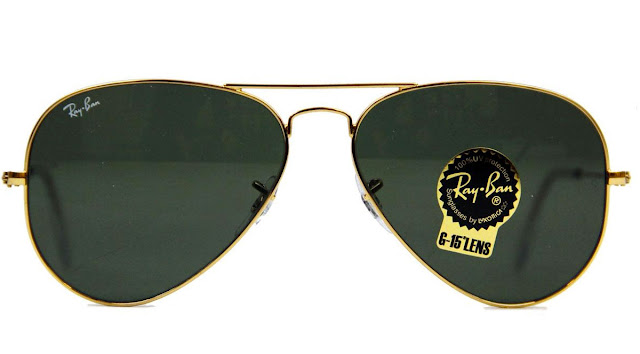"Cool was invented in 1937..."
- The Aviator, Ray-Ban icons
The staple of any Retro Sunglasses collection, the Aviator was developed by Bausch & Lomb (the original owners of Ray-Ban) in 1936 and the design patented in 1937.
In the 1920s, new technology in planes meant that pilots were able to fly higher and for longer periods than previously. Some pilots complained that the extended exposure to the sun's glare was giving them headaches and altitude sickness. In 1929, US Army Air Corps Lieutenant General John MacCready asked Bausch & Lomb, who at the time were a New York-based medical equipment manufacturer, to create a pair of sunglasses that would reduce the headaches and nausea experienced by pilots.
The prototype to the Aviator, then called 'anti-glare' sunglasses, was designed in 1936 with plastic frames and green lenses, designed to cut out the glare without impeding vision. The design was updated to its now instantly recognisable thin metal frame the following year and renamed the Ray-Ban Aviator; Aviator after the pilots and the name Ray-Ban chosen to convey that these sunglasses literally banned the rays from the suns from the wearers eyes. The original design featured Ray-Ban's G-15 tempered glass lenses, transmitting 15% of incoming light. The large lenses are slightly convex shaped, to cover the entire range of the human eye and prevent as much light as possible from entering the eye from any angle.
As well as pilots, other groups of people soon found the Aviator useful for purposes. A couple of years after the classic Aviator was developed, Ray-Ban developed a sister style, The Outdoorsman, specifically for activities such as hunting, fishing and shooting.
In the 1940s, gradient lenses and mirror lenses were introduced. These lenses featured a special coating on the upper part of the lens for extra protection, but an uncoated lower lens for a clear view of an aeroplane's controls and instruments.
 |
| "People of the Philippines: I have returned" - General MacArthur wades ashore in 1944 |
During World War II, the Aviator gained more fame in the mainstream after American army General Douglas MacArthur landed on the beaches in the Philippines in 1944. Dramatic newspaper photographs showed him (and other army personnel) wearing Aviator sunglasses, as they waded ashore. "People of the Philippines: I have returned," said General MacArthur in his speech that day.
In the 1950s and 1960s the Aviator grew in popularity moderately. The oversized style, allowing a lot of coverage for the wearer, meant that soon Aviator sunglasses were being adopted by celebrities and politicians.
 |
| Gloria Steinem |
In the late sixties and early seventies, writer and feminist spokesperson, Gloria Steinem became well known for wearing aviator glasses and sunglasses, when she was pictured wearing them during her political speeches and events for women's rights and the feminist movement.
In the 1970s, the Aviator became one of the key looks of the era, with the popularity of disco and 70s rock, with people choosing to wear the style not only as sunglasses, but as prescription glasses too.
Robert Redford shows this in his role as Joseph Turner in 1975 spy movie, Three Days Of The Condor. The pairing of the Aviator Sunglasses with a naval peacoat is another vintage 1970s inspired look.
 |
| Robert Redford in Three Days of The Condor |
Many musicians in the 1970s adopted the Aviator as their signature look, perhaps none so much as ELO frontman and later Beatles producer, Jeff Lynne, who is almost never seen without a pair. (Does anyone know what his eyes look like?!)
In the official video for ELO's 1979 classic, Don't Bring Me Down (above) Jeff Lynne wears iconic Aviator sunglasses. It's something he's still wearing in the video for recent ELO release, When I Was A Boy from 2015 (below). Over thirty-five years of Aviator wearing!
Sylvester Stallone also wore Aviator Sunglasses in his blink-and-you'll-miss-it cameo in Stayin' Alive, directed and written by Stallone in 1983.
Following the demise of disco in the 1980s, however, the Aviator's popularity also fell significantly since it's inception in the 1930s, with the backlash against disco and the disco look.
This hit the sunglasses industry - and Ray-Ban themselves - quite hard. To combat the decline in sales, Ray-Ban signed a lucrative product placement deal in 1982, to place Ray-Ban sunglasses in top movies and TV shows.
The first big pay-off for the Aviator from this deal was in 1986 with the release of two major movies, which both featured Aviator sunglasses heavily - Cobra, starring Sylvester Stallone and perhaps most iconically, Top Gun with Tom Cruise donning a pair of classic Aviators (and at times, other Ray-Ban aviator styles). The impact of this was a 40% increase in Ray-Ban's Aviator Sunglasses sales.
Since it's creation in 1937, the Aviator has become one of the most iconic styles of sunglasses ever. Ray-Ban still make the classic Aviator in it's original gold/green, gold/brown, silver/mirror and gunmetal/green colour options as well as many seasonal colours and styles. Leading on from the original Aviator, Ray-Ban has also added new styles to it's icons range, based on the style including Caravan, Cockpit, Cats 5000, Shooter and Outdoorsman (look out for articles on each of these soon!)
Find more Ray-Ban Aviator Sunglasses here.

.png)










No comments:
Post a Comment